
Mites are small arachnids. Mites span two large orders of arachnids, the Acariformes and the Parasitiformes, which were historically grouped together in the subclass Acari. However, most recent genetic analyses do not recover the two as each other's closest relative within Arachnida, rendering the group non-monophyletic. Most mites are tiny, less than 1 mm (0.04 in) in length, and have a simple, unsegmented body plan. The small size of most species makes them easily overlooked; some species live in water, many live in soil as decomposers, others live on plants, sometimes creating galls, while others are predators or parasites. This last type includes the commercially destructive Varroa parasite of honey bees, as well as scabies mites of humans. Most species are harmless to humans, but a few are associated with allergies or may transmit diseases.

The Acariformes, also known as the Actinotrichida, are the more diverse of the two superorders of mites. Over 32,000 described species are found in 351 families, with an estimated total of 440,000 to 929,000 species, including undescribed species.

Parasitiformes are a superorder of Arachnids, constituting one of the two major groups of mites, alongside Acariformes. Parasitiformes has, at times, been classified at the rank of order or suborder.

The peacock mites of the genus Tuckerella are a significant herbivorous pest in the tropics, for example on citrus fruit. Other species dwell in grasses, possibly as root feeders.
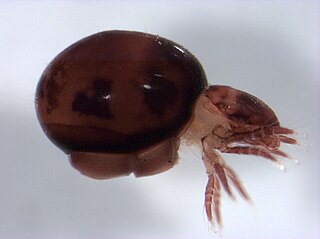
Oribatida, also known as oribatid mites, moss mites or beetle mites, are an order of mites, in the "chewing Acariformes" clade Sarcoptiformes. They range in size from 0.2 to 1.4 millimetres. There are currently 12,000 species that have been identified, but researchers estimate that there may be anywhere from 60,000 to 120,000 total species. Oribatid mites are by far the most prevalent of all arthropods in forest soils, and are essential for breaking down organic detritus and distributing fungi.

Feather mites are the members of diverse mite superfamilies:
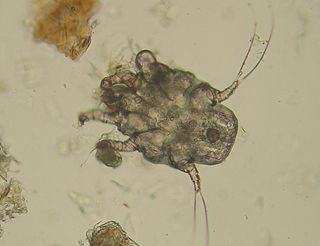
Astigmatina is a clade of mites in the superorder Acariformes. Astigmata has been ranked as an order or suborder in the past, but was lowered to the unranked clade Astigmatina of the clade Desmonomatides in the order Sarcoptiformes. Astigmatina is now made up of the two groups Acaridia and Psoroptidia, which have been suborders of the order Astigmata in the past. Astigmatina contains about 10 superfamilies and 76 families under Acaridia and Psoroptidia.

Psoroptidia is a parvorder of the Acari (mite) group Astigma. It comprises around 40 families, and apparently originated as parasites of birds, before a secondary radiation saw some taxa become parasites of mammals. Because of their parasitic lifestyle, members of the Psoroptidia do not exhibit a deutonymph stage.

The Proctophyllodidae are a family of the Acarina (mite) order Astigmata. They contain many feather mites. The Alloptidae and Trouessartiidae were in earlier times included here as subfamilies.

The central Sulawesi echiothrix is a species of rodent in the family Muridae. It is found only in Sulawesi, Indonesia.
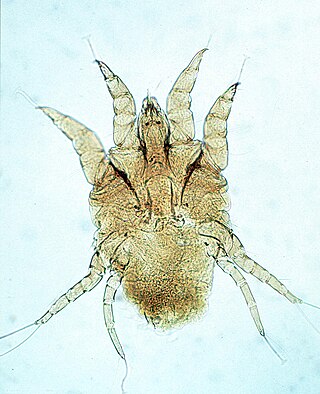
Sarcoptoidea is a superfamily of mites, including many associated with mammals.

Phoresis or phoresy is a temporary commensalistic relationship when an organism attaches itself to a host organism solely for travel. It has been seen in ticks and mites since the 18th century, and in fossils 320 million years old. It is not restricted to arthropods or animals; plants with seeds that disperse by attaching themselves to animals are also considered to be phoretic.
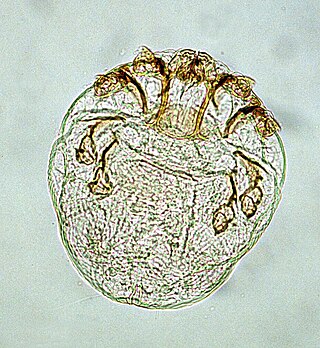
Knemidokoptes is a genus of parasitic mites in the family Epidermoptidae that infect the skin or feather follicles of birds, especially gallinaceous birds as well as parakeets and canaries. Infection commonly causes scaly lesions to form at the face or feet, which is known as knemidocoptiasis.
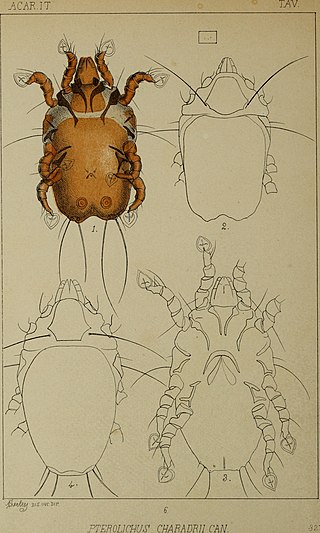
Avenzoariidae is a family of feather mites in the order Astigmata. There are at least 15 genera in Avenzoariidae. They are found on the feathers of aquatic birds, and in the case of one species, birds of prey.
Freyanidae is a family of feather mites in the order Astigmata. There are more than 15 genera in Freyanidae.

Chaetodactylidae is a family of mites in the order Sarcoptiformes. There are five genera: Sennertia, Chaetodactylus, Achaetodactylus, Centriacarus, and Roubikia.

Winterschmidtiidae is a family of mites in the order Astigmata.

Glycyphagus is a genus of astigs in the family Glycyphagidae.

Glyphanoetus is a genus of astigs in the family Histiostomatidae.

Kiwalges haastii is a species of New Zealand feather mite in the superfamily Analgoidea, known only from the great spotted kiwi, from which it derives its name.

















